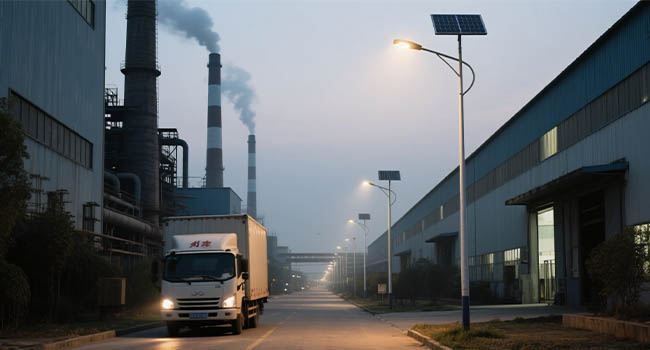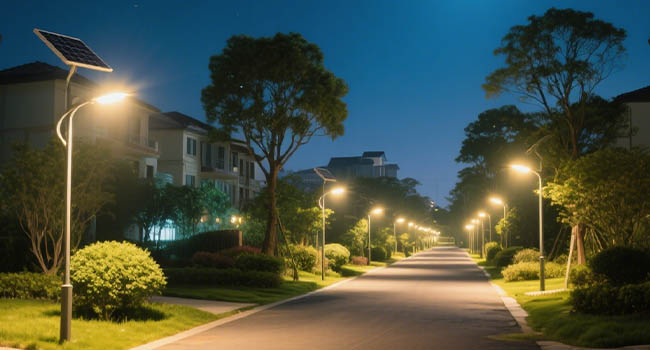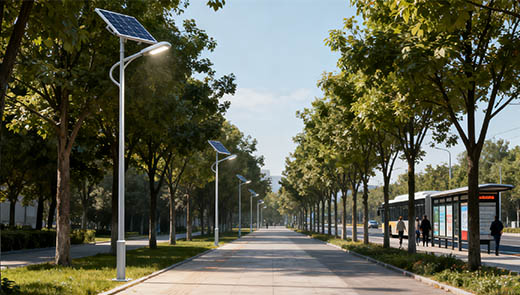What Are the Factors Affecting the Quality of LED Street Lights?
In the fields of urban construction and road lighting, the application of LED street lights is becoming increasingly widespread. However, the quality of LED street lights varies greatly, which not only affects lighting performance but also impacts public safety and cost investment. What factors are influencing the quality of LED street lights? We will delve into this topic below to uncover the underlying secrets.

Why are LED street lights becoming more and more popular?
In recent years, LED street lights have secured a significant position in the outdoor lighting market, with their popularity continuing to rise. This trend is driven by several key factors.
Energy efficiency
LED street lights demonstrate significant energy-saving advantages. Traditional incandescent bulbs convert a large portion of electrical energy into heat during operation, with only a small fraction converted into light energy. In contrast, LED street lights have extremely high energy conversion efficiency, typically achieving energy savings of 60%–80% compared to traditional incandescent bulbs, significantly reducing power consumption and operational costs.
Environmental protection
LED street lights also perform exceptionally well. They do not contain harmful substances such as mercury, thereby avoiding environmental pollution caused by the disposal of traditional lighting fixtures. Additionally, LED street lights produce minimal light pollution, with more evenly distributed light, minimizing disruption to nearby residents' daily lives and activities such as astronomical observations.
Lifespan
LED street lights have a significant advantage. The lifespan of traditional incandescent bulbs is typically around 1,000–2,000 hours, while the average lifespan of LED street lights can reach 50,000–100,000 hours. This means that LED street lights require much less frequent replacement, reducing waste of human and material resources and lowering maintenance costs.
Safety performance
LED street lights also excel in safety performance. Their lower heat output reduces the risk of fires caused by high temperatures. Additionally, LED street lights can start up quickly and reach full brightness instantly, providing timely and adequate lighting for pedestrians and vehicles at night, thereby effectively enhancing road safety.

Importance of street light quality
LED street lights are closely connected to people's daily lives, and their quality issues are of great concern. Poor-quality LED street lights can lead to a series of negative impacts. In terms of lighting effects, low-quality LED street lights may exhibit uneven illumination and unstable brightness. Some areas may be overly bright, causing glare that irritates pedestrians' and drivers' eyes; while other areas may be inadequately lit, creating visual blind spots that increase the likelihood of traffic accidents.
From a health perspective, substandard LED street lights with excessively high blue light content can damage the retina of the human eye. Prolonged exposure to such lighting environments may also disrupt the body's circadian rhythm, interfering with normal sleep and physiological cycles.
From an economic perspective, low-quality LED street lights frequently malfunction, requiring multiple repairs and replacements, which inevitably significantly increases the operational costs of public lighting systems and results in resource waste.
Factors affecting the quality of LED street lights
The type of LEDs used
There are numerous types of LEDs available on the market today, with varying prices. However, a higher price does not necessarily guarantee better quality. The type of LEDs used in street lights significantly impacts their overall quality and performance. When selecting LEDs for street lights, high lumen output and long lifespan are two key considerations.
From a luminaire type perspective, there are primarily two types of LED street lights: traditional “snake-head” luminaires and more modern, stylish designs.
|
Lamp Type |
Features |
Advantages |
Disadvantages |
|
"Snake Head" Lamp |
Designed to project a wide beam of light |
Effectively illuminates large areas |
Generates significant glare, which can disturb pedestrians and drivers |
|
Modern Stylish Lamp |
Ultra-thin design with a narrower light beam |
Helps reduce glare and improve street safety |
— |
When selecting LED street lights, it is essential to consider both the quality of light and the specific needs of the community.
Thermal management
Heat dissipation management is critical to the overall quality and lifespan of LED street lights. LEDs are sensitive to heat, and when temperatures become too high, LEDs can experience performance degradation, shortening their lifespan and reducing overall quality. A good heat dissipation management system can keep LEDs at a low temperature, thereby extending their lifespan and improving performance.
Currently, there are several methods for managing the heat generated by LEDs. One common approach is to use heat sinks to dissipate heat from the LEDs into the surrounding environment; another option is to use fans to actively cool the LEDs. However, the core of any thermal management system lies in ensuring that LED street lights remain at a low temperature during operation. Through effective thermal management, the lifespan of LED street lights can be significantly extended, and their optimal performance can be ensured.

The wiring
Proper wiring is critical for any electrical system, including LED street lights. Improper wiring can lead to various issues, such as short circuits, fires, and electric shock risks. Therefore, it is essential to use high-quality wires and connectors and ensure that the streetlight wiring is installed correctly.
While using lower-quality cables and connectors may save costs initially, frequent replacements will result in higher expenses in the long run. Additionally, poor-quality wiring poses serious safety hazards, so it is wise to exercise caution when installing streetlight wiring. To ensure the safety and reliability of street lights, it is essential to use the highest-quality materials for wiring installation.
The controls
LED street lights are highly favored for their energy-saving advantages, and their remote control functionality is a major highlight. The control system allows users to dim the lights during specific time periods or completely turn off the street lights when lighting is not needed, which not only significantly saves energy but also reduces electricity costs.
An excellent control system should allow users to fully control the street lights and make adjustments quickly and easily. Additionally, it is crucial to choose a control system compatible with the specific type of LED streetlight. With numerous control systems available on the market, leveraging this practical technology can enhance the efficiency and functionality of LED street lights.
The installation
As an energy-efficient lighting alternative, LED street lights offer clear advantages, but improper installation can lead to issues such as uneven lighting, flickering, and premature failure. To ensure proper operation and longevity, installation must be performed by professionals with experience in LED installation. Professional installers are familiar with the complex structure of LED street lights and can ensure all components are correctly installed, enabling the street lights to provide reliable lighting services for years with minimal maintenance costs.
Maintenance
Like other types of lighting equipment, LED street lights require regular maintenance to ensure they remain in optimal working condition. Maintenance tasks include cleaning debris from the lamp lenses, replacing damaged LED light sources, and checking that the drivers are functioning properly.
Regular maintenance not only extends the lifespan of the street lights but also ensures their continuous and stable lighting. street lights are an important component of the community, providing safety and security for residents and businesses. However, without proper maintenance, street lights can quickly become a safety hazard. Therefore, establishing a regular inspection and maintenance schedule is essential to avoid high repair costs and ensure a bright and safe community.

How to ensure the quality of LED street lights
After understanding the factors that influence the quality of LED street lights, taking effective measures to ensure their quality becomes crucial. The following provides methods and recommendations to ensure the quality of LED street lights across multiple stages.
Strictly screen suppliers and products
During the procurement phase, selecting reliable LED street light suppliers is crucial. Prioritize companies with a good reputation, extensive production experience, and a comprehensive quality certification system (such as ISO quality management system certification and relevant international product certifications). Carefully review the product's technical specifications, focusing not only on basic indicators like LED type, lumen output, and lifespan but also on details such as heat dissipation design and electrical safety standards. Request samples from suppliers for actual testing to observe their lighting effects, heat dissipation performance, and stability, ensuring product quality meets expectations.
Standardize installation procedures and supervision
The installation process directly impacts the subsequent performance of street lights and must be strictly carried out in accordance with standards. Construction teams should possess professional LED streetlight installation qualifications and experience. Prior to installation, conduct a detailed site survey to determine the optimal installation location and height based on road conditions. During installation, supervisors must oversee the entire process, checking whether the wiring connections are secure, the lamp installation angles are accurate, and the grounding protection meets requirements. After installation, conduct comprehensive testing and inspection to ensure all functions of the street lights operate normally.
Establish a comprehensive maintenance system
Regular maintenance is a key means of maintaining the optimal performance of LED street lights. Develop a detailed maintenance plan specifying maintenance cycles and specific maintenance tasks. For example, conduct monthly visual inspections and simple checks, quarterly inspections of the electrical system, and annual professional testing of key indicators such as light decay and color temperature of the fixtures. Additionally, establish maintenance records to document the time, content, issues identified, and resolution of each maintenance session, enabling timely monitoring of the street lights' operational status and proactive identification and resolution of potential issues.
Implementing intelligent monitoring and feedback mechanisms
Utilize modern information technology to equip LED streetlight systems with intelligent monitoring devices. Sensors can collect real-time operational data such as current, voltage, and temperature, and transmit this data to a management platform. Upon detecting abnormal conditions, the system can promptly issue alerts to notify maintenance personnel for resolution. Additionally, user feedback—such as residents' and drivers' evaluations and suggestions regarding lighting effectiveness—can be collected. By combining this feedback with monitoring data, street lights can be optimized and adjusted to continuously improve lighting quality and user experience.
Quality control for LED street lights is a systematic process encompassing technology selection, engineering implementation, and long-term management. From the performance of core LED chips to the rationality of hardware designs such as heat dissipation and wiring, and from installation standards to the construction of intelligent operation and maintenance systems, each links is interconnected, collectively determining whether street lights can fulfill their role in providing safe lighting and energy-saving benefits on urban roads.




